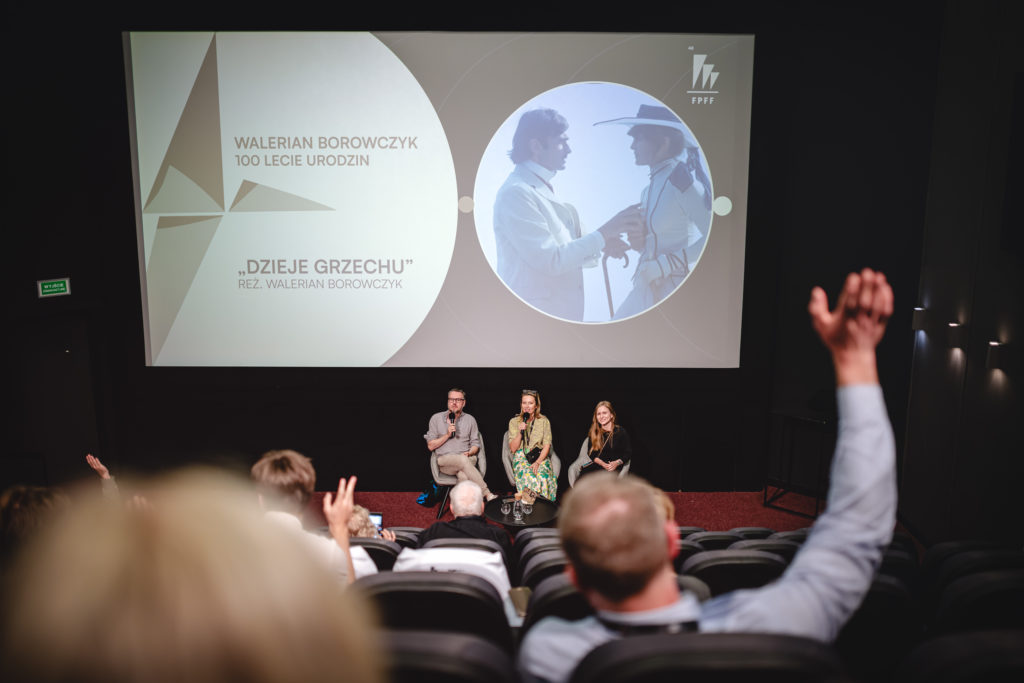Does a scandalous film still stir the public after half a century?

photo T. Kamiński
This year is the 100th anniversary of Walerian Borowczyk’s birthday – one of the most unique and controversial creators in the history of cinema. Agnieszka Szydłowska, Dorota Masłowska and Kuba Mikurda discussed his work after the special screening of The Story of Sin in Gdynia.
Mateusz Demski
The Story of Sin is the third adaptation of Stefan Żeromski’s novel, which drew a record number of eight million viewers to the Polish cinemas in 1975. The film was dubbed scandalous, and its director – who was already considered a master of film eroticism – managed to fit right into the moment in history, when the sexual revolution arrived in Poland, a couple years late. For him it was a return to his homeland. The Story of Sin is the only feature film created by Borowczyk in Poland.
Kuba Mikurda: Borowczyk worked in Poland until 1959. He was an animator. His film House, created together with Jan Lenica, was so successful, that he moved to France. In France he kept making animated films and was dubbed “Kafka of animation”. In 1968 he started to make live action films and immediately people wanted Borowczyk to shoot something in Poland. Stanisław Różewicz, artistic director of the TOR Film Production, tried to get him back home to direct Słowacki’s Mazeppa. It didn’t work out. Borowczyk directed Mazeppa as his second film in France titled Blanche. Then he made Immoral Tales, which shocked with the overabundance of eroticism. That’s when he was finally convinced to come back to Poland to direct The Story of Sin.
Talking about Borowczyk on the 100th anniversary of his birthday has to include the question, how much sense – if any – does watching The Story of Sin half a century later make? What may be interesting in this film today? And does this revolting, scandalous film still stir the public at all?
Dorota Masłowska: For me this film is an enigma. I’m still trying to wrap my head around how it’s made. The first thing that comes to my mind are protopornographic films. I also thought about how sex is show in cinema today, about how much what we see on the screen interferes with watching this film. It makes it harder to imagine what it felt like in 1975.
Kuba Mikurda: That’s the difficult life of pioneers who lead with what is revolutionary at the time but soon becomes anachronistic.
Another issue mentioned at the meeting was the literary source and the way it made us look at the woman, whose story ends so tragically.
Dorota Masłowska: What came to my mind as well is how this film’s story corresponds to the one of The Peasants which is also screening at the festival. It’s a story of a woman doomed because of her carnality and beauty. It’s the same with William Faulkner’s The Sanctuary, where a woman’s beauty also makes her a victim of a man’s violence and captivity. These are the stories of how women, whose only fault was their beauty, lost their identity.
Kuba Mikurda: The heroines of Goto, Blanche and The Story of Sin follow their desire and find strength in doing so, but they all end up punished for it and die in the end. It’s an issue of the emancipatory potential of the story. It changed. The heroines of the cinema of the 70s aren’t punished. They go on and get their revenge.
This leads us to the reception of the film and how it affected Grażyna Długołęcka’s career. As the star of the film, she was identified with the character.
Agnieszka Szydłowska: The reception of Borowczyk in Poland varied. We know the film was well received in the West, but the actress was punished, she received a lot of hate, in modern terms. Some even directly attacked her. While walking down the street, even her mother was targeted. She was being told, and I quote, “this is the daughter she raised”. She was ostracised by the industry. She didn’t get any roles. There was a disturbance. She was deemed responsible, but for what? – That’s the question.
Another part of the story is the fact that Borowczyk, while presenting the circle of abuse of women, might have been responsible for it himself. That’s what Długołęcka said in one interview years later, that her work with Borowczyk was a source of her trauma.
So I ask, how should we treat his work and particularly The Story of Sin after all these years?
Dorota Masłowska: I’m also wondering if it’s worth fantasising about a more modern version of the book. I’m not so sure. I’m curious, though, how someone who tries it, would tackle this now unacceptable moral notion of a woman punished for her passion.
Agnieszka Szydłowska: Let’s get back to the question at hand. What does the film do to us in 2023? It’s kind of the same as the notion not to “cancel” In Desert and Wilderness, to talk about how it was written, while showing how the world has changed. We’re about to go and watch The Peasants and Jagna will once again land in a pile of muck… One might ask, what’s going on with all the modern cinema creating the same stories, with the same message?
Dorota Masłowska: I’d say that if you want to bring this book into the discussion, you should turn your attention to a woman who possesses a resource in her beauty and tries to manage it herself but keeps running into men who try to claim it and “own” it. This is the story that keeps getting reborn and is forever present.

